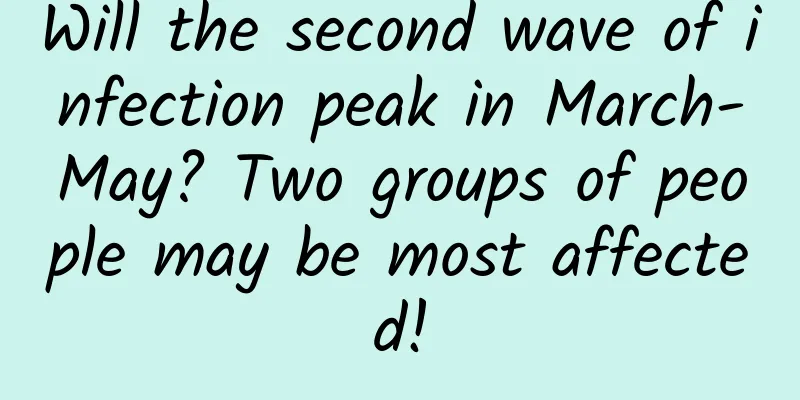Will the second wave of infection peak in March-May? Two groups of people may be most affected!

|
During the Spring Festival that just passed, there was no significant rebound in the epidemic. With the emergence of the Omicron variants CH.1.1, XBB.1.5, BQ.1.1, BQ.1 and XBB, people are very concerned about the possible second wave of infection peak. Recently, the topic of "the second wave of infection peak may be from March to May" has also become a hot search. Why is the second wave of infection peak predicted to be between March and May? Xing Mingyou, chief physician of the infectious department of Tongji Hospital affiliated to Tongji Medical College of Huazhong University of Science and Technology, analyzed in an interview with Yangtze River Daily on January 31 that from the perspective of virology and epidemiology, the antibody level in the body will maintain a relatively high peak for 3 to 6 months after "Yang Kang", and there is only a 2% probability of reinfection in a short period of time. However, our country has a very large population base. Starting from December last year, after another 3 to 6 months, our antibody levels will slowly decline. At this time, if there is a new virus variant, we are very likely to develop clinical symptoms after reinfection, and there is still a possibility of a peak. Professor Xing Mingyou predicts that the second wave of infection peaks may come in March-May, but this time the peak may not be so obvious to the public. Because everyone was infected at different times, and because we have a basic antibody level after the second infection, the number of people infected in the second round, the severity of infection symptoms, and the degree of time concentration will be much weaker than the first time. Lu Mengji, a German-Chinese virologist and professor at the Institute of Virology at the Medical School of the University of Essen, also said in an interview with China Newsweek on February 1 that it is expected that from late March this year, as people's immunity declines, the risk of infection will increase. In May and June, the epidemic situation will change significantly, and we may face a second wave of impact. But whether the second wave of the epidemic will occur in March or May and June depends on whether a new strain with a very strong impact will appear. Two groups of people may be greatly affected in the future 1. The elderly who are still recovering Professor Lu Mengji, a virologist and professor at the Institute of Virology, Medical School, University of Essen, Germany, said in an interview with China Newsweek that many elderly people who have been infected are now in the recovery period, and many people with poor physical fitness may be infected again, and the consequences may be very serious. At this stage, some high-risk groups with immune deficiencies who have not been infected may also face the impact of the next wave of the epidemic. 2. People who have not yet been infected Currently, the people who have not been infected are the most affected by the epidemic, estimated at 15% to 20%. Compared with the previous situation where the entire population was susceptible, the impact has been reduced, but given my country's population base, the scale of the population involved is still very large. What can we do? Do two things well If everyone takes the first responsibility for their own health, maintains social distance, and develops good hygiene habits, infection and secondary infection can be prevented to a large extent. 1. Keep wearing a mask Professor Xing Mingyou, chief physician of the infectious department of Tongji Hospital affiliated to Tongji Medical College of Huazhong University of Science and Technology, reminded in an interview with Yangtze River Daily that masks must be worn in a standardized manner, especially in public places with dense crowds. It is sufficient for ordinary people to wear medical surgical masks in regular travel. In some high-risk positions and environments, the probability of infection increases and N95 masks need to be worn. 2. Three groups of people will be given priority for vaccination Professor Xing Mingyou said in an interview with Yangtze River Health Media that since the antibodies produced after the first infection have disappeared six months after "Yang Kang", it is very necessary to boost the vaccine at this time. Vaccination can delay the time of infection, or reduce the probability of infection. Three groups of people are recommended to be vaccinated first: 1. Work in high-risk positions such as doctors, couriers, etc.; Second, elderly patients with underlying diseases such as diabetes, hypertension, tumors, or patients who have undergone dialysis or transplantation; 3. For people who developed pneumonia during the first infection and were hospitalized for severe symptoms, they must receive a booster vaccine 6 months after the first "Yang Kang". |
Recommend
What superstitions do your parents have that actually have a scientific basis?
One minute with the doctor, the postures are cons...
Help Alibaba Pictures calculate whether it is a loss or not after buying Star Cinema for 100 million yuan
The board of directors of Alibaba Pictures announ...
The more you stay up late, the more awake you are? ——The harm of staying up late (Part 1)
This is the 3721st article of Da Yi Xiao Hu "...
App Fairness Alliance launches initiative to make iOS app distribution like Windows
The nonprofit Coalition for App Fairness wants to...
Mobile game entrepreneurs worry about approval time: everything is cold in half a year
On June 31, 31 mobile games were launched; in Jul...
White spots on nails are not caused by calcium deficiency! The nails that really need to be worried are like this...
We give so much meaning to our nails! "My na...
Challenges facing humanity: Increasingly invasive species
Produced by: Science Popularization China Produce...
Analysis of Zhihu marketing in men’s skin care products
"Male beauty economy" is an industry te...
Analysis & Cases | A comprehensive understanding of the five dimensions of user portraits in the financial industry
1. Why does the financial industry need to create...
Like a ball but not a ball? The "very basic problem" that has troubled the mathematical community for 30 years has finally been solved
Five mathematicians have not only solved a diffic...
There are many lunar exploration orbits, and the key is to choose wisely
Recently, NASA launched the first lunar explorati...
Let’s be honest: if you slack off while working, you will be more tired!
Have you ever had such an experience of "sla...
The most complete! Summary of Zhihu’s traffic marketing strategies!
Did you know: What kind of brands are suitable fo...
Why was the tiger talisman used to mobilize millions of troops in ancient times in the shape of a tiger? Why can it only be stolen and not forged?
On the eve of the Chinese New Year of the Tiger, ...









